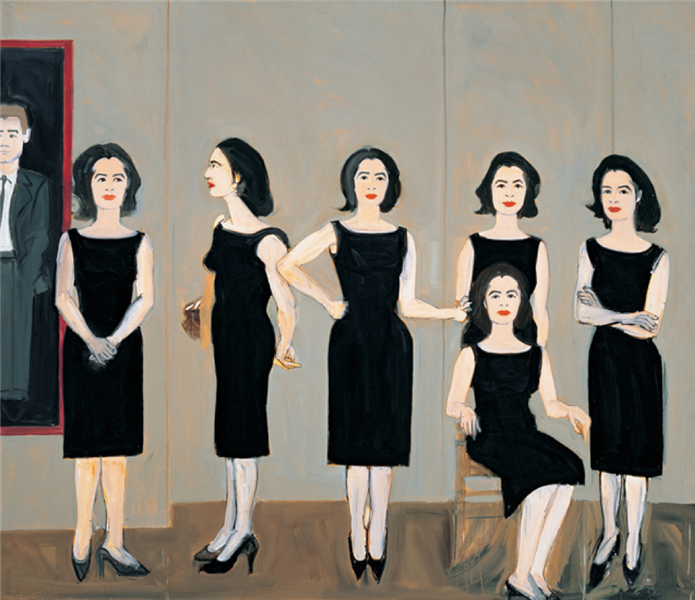American figurative painter Alex Katz is well-known for his powerful, simple forms, flattened compositions, and vivid colour schemes that define his painting style. Born in Brooklyn, New York, in 1927, Katz rose to prominence in the 1950s American art scene and is now recognised for his contributions to modern art. Katz’s early work was influenced by abstract expressionism, but he eventually turned to painting figuratively, primarily focusing on landscapes and portraits. He created a distinctive method that uses sparse yet expressive brushwork to highlight the core of his themes.
Katz’s use of enormous canvases, which enable him to produce immersive and powerful portrayals of his topics, is one of his most famous approaches. Friends, relatives, and other people in his social circle are frequently seen in his pictures in informal conversation or silent reflection. Katz also uses strong strokes and primary forms to convey the essence of a subject in his landscape paintings, creating an atmosphere and sense of place with colour and arrangement.
Katz has won various accolades for his contributions to the arts, including the National Academy Museum and School of Fine Arts’ 2007 Lifetime Achievement Award. He is a prominent and prolific presence in modern art, with his work found in essential institutions and collections across the globe. Katz is a well-known figure in figurative painting because of his ability to capture the essence of his topics in arresting visual statements. His work never fails to enthral and inspire viewers all around the world.
Art and Life of Katz
Alex Katz is critical in modern art, especially figurative painting and portraiture. Katz created a unique aesthetic with vivid hues, flattened perspectives, and solid and simple forms. Though he was influenced by several artistic genres, such as Pop Art and Abstract Expressionism, in the end, he developed a painting style that was all his own. Katz’s paintings frequently depict large-scale landscapes and people, evoking the purity and immediateness of ordinary life experiences.

In the era of abstract art’s ascendancy in modern art, Katz’s dedication to figurative painting was revolutionary. Through his portrayals of friends, family, and acquaintances, he explored themes of identity, beauty, and perception, revitalising the genre of portraiture with a modern perspective. Katz’s paintings have an air of sophistication and beauty because of his minimalist compositions and focus on surface and shape. He produces visually arresting and emotionally stirring images by eliminating extraneous details and concentrating on what matters most.
It is impossible to overestimate Katz’s influence on artists of later generations. His audacious painting style and creative method have influenced many artists in various media, including fashion, photography, sculpture, and painting. Artists like Elizabeth Peyton, John Currin, and Peter Doig have all been influenced by Katz.
Katz is still an active and significant person in the art world even though he is in his 90s. His paintings are still on display in prestigious galleries and museums across the globe, and his constant experimentation with colour, form, and space pushes the limits of figurative painting.
“A lot of people want to paint something timeless, but I paint the immediate present.”-Alex Katz
‘From the beginning of his artistic career, Alex Katz seems to have taken to heart the Baudelairean postulate. The question he confronted after graduating from Cooper Union in New York in 1949 was how exactly to capture the tenor of his times. The European modernist tradition, including Manet, was one source Katz turned to in search of alternatives to the dominant aesthetic idiom of modernity at the time, namely Abstract Expressionism. While he admired Jackson Pollock, Willem de Kooning, and Franz Kline, Katz was not interested in abstract painting; he wanted to reinvent figuration. Turned off by what he saw as the pathos and psychologism of the New York school, he opted for the figure not as an interiorized subject but as a cypher, a signpost for the “here and now.” As Baudelaire maintained, it was in “the attitude and gesture of living beings” that the gist of contemporaneity resides’, writes Ewa Lajer-Burcharth.
Katz’s wife, Ada, was a significant inspiration and model for the painter and his favourite subject. Katz started painting portraits in the late 1950s, and in the series of these early works, she is one of the two key components—figure and ground—that characterise the artist’s simplified approach to portraiture. With a monochromatic background of either spring pea green or blue-white, her body is a formidable opponent. Ada’s lonesome demeanour occasionally evokes memories of Manet’s 1860s paintings of Victorine Meurent, leading one to draw comparisons between the roles played by the models in these artists’ creations.

According to Burcharth, ‘When, in the early 1960s, Katz started to fill large-scale canvases with tightly cropped heads, he was emulating the cinematic close-up. “I loved movies,” Katz has said. “I loved how the wide-angle screen was used, and the rectangle was broken up. It was quite original if you think of it in terms of painting.” Katz observed the effects of cinematic framing by distancing himself from the screen and reflecting on how what he saw there was produced—no small feat given the invisible operations of the cinematic apparatus, which immerses the viewer in the flow of images. Stepping back from this narrative flow, Katz could discern the workings of the frame and adopted the device for his aesthetic purposes.
The best way to characterise Katz’s figures’ level of abstraction is as distillation since their unique appearance results from a more intricate aesthetic process than just physical subtraction— the extraction of meaning from appearances. The idea of distillation dates back to Baudelaire, who considered it to be the fundamental tactic of the modern life painter: “Any “modernity” that is worthy of eventually replacing “antiquity” must have the enigmatic beauty that human life unintentionally imbues in it extracted from it.”
Rising to prominence in modern art, Alex Katz is renowned for his bold compositions, signature style, and unforgettable depictions of American life. Despite its contemporary appeal, Katz has produced a body of ageless work thanks to his mastery of colour, form, and composition. For over seven decades, Katz has continuously pushed the limits of figurative painting, embracing realism and abstraction to produce arresting and emotionally impactful works. His still lifes, landscapes, and portraits all have an unmistakable closeness that entices viewers into his world while yet projecting a feeling of cold detachment.





